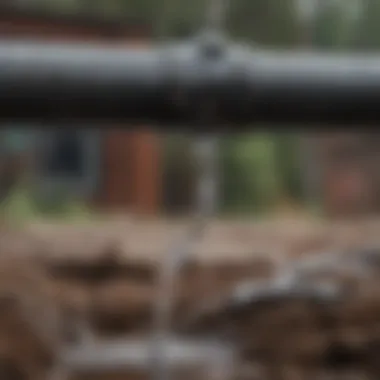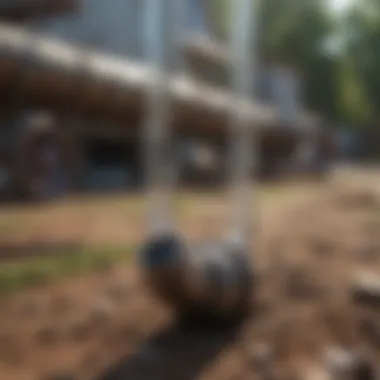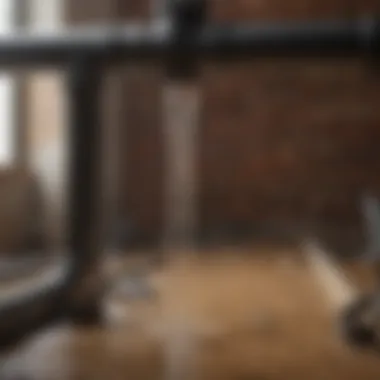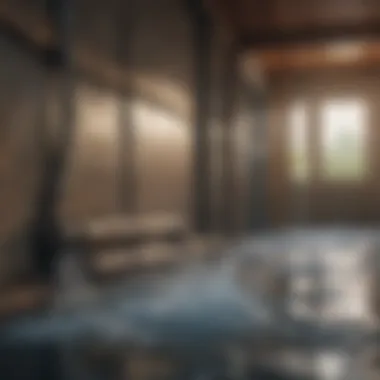Understanding Broken Water Pipe Insurance: Coverage & Claims


Intro
Understanding the complexities of broken water pipe insurance is crucial for homeowners and renters alike. Water damage can occur suddenly and lead to significant financial loss. This section aims to provide clarity about the financial product that addresses this risk, allowing policyholders to navigate their options effectively.
Overview of Financial Product
Definition
Broken water pipe insurance is a type of coverage that protects against damages resulting from burst or leaking pipes. This insurance usually falls under a broader homeowners or renters policy. However, specific endorsements may also focus solely on water-related incidents.
Key Features
- Comprehensive Coverage: This insurance generally includes damage to the interior of your home, personal belongings, and even the structure itself.
- Loss of Use: If water damage renders the home uninhabitable, this coverage may help with temporary living expenses.
- Emergency Repairs: Some policies include provisions for urgent repairs to prevent further damage.
Purpose and Benefits
The main purpose of broken water pipe insurance is to alleviate the financial burden that often accompanies plumbing failures. Not having this insurance can lead to out-of-pocket expenses that may run into thousands of dollars. Key benefits include financial protection, peace of mind, and the ability to recover from damage much faster.
Types and Categories
Insurance Types
- Homeowners Insurance: Most homeowners policies cover some water damage but may have limits or exclusions.
- Renters Insurance: This type also often offers coverage for personal belongings damaged by water issues.
- Flood Insurance: For homes in flood-prone areas, additional flood insurance is necessary.
Pros and Cons
Pros:
- Financial protection against costly repairs.
- Provides assistance with temporary living arrangements during repairs.
Cons:
- Premium costs can add up over time.
- Some policies may have caps on coverage amounts.
Situational Uses
- Home owners with older plumbing systems are particularly vulnerable and should consider enhancing their coverage.
- Renters in older buildings may face similar risks from their plumbing infrastructure.
Application Process
Steps to Apply
- Research Providers: Begin by comparing quotes and coverage options from various insurers.
- Request Quotes: Get personalized quotes that suit your specific circumstances.
- Review Policy Details: Understand what is included in the terms and conditions.
Eligibility Requirements
Eligibility typically involves being a homeowner or renter, though specific requirements can depend on the type of policy chosen.
Documentation Needed
- Proof of residence
- A home inspection report may be necessary in some cases
- Prior insurance information
Common Mistakes to Avoid
- Not reading the fine print can lead to misunderstanding coverage limits.
- Failing to disclose previous water damage can impact claims.
Tips for Success
Review policies annually to ensure they still meet your needs. Also, consult with your insurance agent for advice tailored to your situation.
Costs and Fees
Types of Fees Associated
Costs may include premiums, deductibles for claims, and possibly inspection fees for older homes.
Premiums for Insurance
The average premium can vary greatly based on location and property condition. Generally, it can range from $300 to $1,000 annually.


Comparisons of Costs Across Options
It's important to compare not simply the premiums, but also the coverage limits and exclusions. This allows you to see which policy provides the best value for your specific situation.
By becoming informed about the nuances of this insurance, you take necessary steps to safeguard against potential legal and financial repercussions associated with water damage.
Prolusion to Broken Water Pipe Insurance
Broken water pipe insurance is a critical aspect of homeownership, especially for those residing in areas prone to plumbing issues. Understanding this insurance can protect individuals and families from significant financial losses due to unexpected water-related damage. Water damage can arise from a variety of sources, such as burst pipes or malfunctioning appliances, leading to extensive repairs and disruptions in daily life. Thus, securing appropriate coverage for such incidents becomes essential.
What is Broken Water Pipe Insurance?
Broken water pipe insurance specifically covers damages that occur due to leaks, bursts, or any other issues related to water pipes in residential properties. This type of insurance is usually included within broader homeowners or renters insurance policies. However, it’s crucial for policyholders to meticulously review their documents to confirm the specifics of what is covered.
Damages from broken pipes can create not only structural issues but also promote mold growth, which can have lasting health implications. Policies may vary significantly, so it is advisable to understand the definitions, limitations, and exclusions involved in the coverage.
Importance of Coverage for Water Damage
Having appropriate coverage for water damage is not just beneficial – it is almost crucial given the commonality of such incidents. Here are a few key aspects to consider:
- Financial Protection: The repair costs associated with water damage can be substantial. Insurance can alleviate the burden of these unexpected expenses.
- Peace of Mind: Knowing that you have insurance can offer significant peace of mind, allowing homeowners to focus on more pressing concerns.
- Health and Safety: Water damage can lead not only to structural problems but also to health risks from mold or mildewed environments. Insurance can help mitigate these risks by covering necessary repairs.
Understanding Water Damage Risks
Understanding water damage risks is crucial for any property owner. Water damage can result from various causes, and knowing the risks can help individuals take proactive measures. Insurance coverage for broken water pipes hinges on understanding these risks. Failing to understand them may lead to inadequate coverage or unexpected out-of-pocket expenses.
Common Causes of Broken Water Pipes
There are several common causes that can lead to a broken water pipe. Some of these include:
- Freezing Temperatures: Water expands when it freezes. If pipes are not adequately insulated, this can cause them to burst.
- Corrosion: Over time, pipes can corrode due to wear and tear, leading to leaks or breaks.
- High Water Pressure: Excessive pressure in the plumbing system can lead to pipe ruptures. Regular monitoring can prevent this.
- Improper Installation: Incomplete or incorrect installation can result in weak points in the plumbing that may fail under pressure.
- Ground Movement: Natural shifts in the ground can put stress on plumbing systems, causing them to crack.
Recognizing the common causes of broken pipes is the foundational step in mitigating damage. Homeowners should monitor their plumbing, especially in areas with harsh weather.
Impacts of Water Damage on Property
Water damage can have a range of impacts on properties, affecting both structure and value.
- Structural Damage: Water can weaken beams and frames, compromising the structural integrity of the home.
- Mold Growth: Moist environments promote mold growth, which can be hazardous to health and can worsen damage.
- Damage to Personal Property: Furniture, appliances, and personal items can be irreparably damaged by water exposure.
- Increased Maintenance Costs: Repairing water damage often requires professional help, adding to ongoing maintenance costs.
- Decreased Property Value: Properties that have a history of water damage may see a decline in market value, impacting resale potential.
Understanding these impacts emphasizes the importance of having adequate coverage for water damage. Homeowners must recognize that being proactive can save both money and stress in the long run.
Types of Insurance Policies Covering Water Damage
Insurance policies for water damage are crucial for homeowners, renters, landlords, and property managers. Understanding the various types of coverage can significantly influence how individuals manage risks associated with broken water pipes. Each type of insurance offers unique provisions, exclusions, and benefits tailored to specific situations. Assessing these options allows individuals to make informed decisions, ensuring adequate protection against water damage incidents.
Homeowners Insurance
Homeowners insurance is typically the first line of defense for property owners. It covers various risks associated with owning a home, including damage from broken water pipes. This type of insurance often includes coverage for both structural repairs and personal property loss.
Standard Exclusions
Standard exclusions in homeowners insurance are essential to understand. These exclusions define what the policy does not cover, which can help homeowners avoid misunderstandings during claims processes. Common exclusions include wear and tear, maintenance neglect, and water damage from improper drainage or flooding. The key characteristic of these exclusions is to encourage proper property maintenance. Although they may seem limiting, they serve to promote responsible homeowner practices. This aspect is significant for those seeking coverage. Knowing these exclusions helps to manage expectations. It can also inform decisions about additional coverage options when needed.
Optional Add-Ons
Optional add-ons can enhance a policy by providing extra coverage that standard provisions might not include. These extensions can cover instances like sewer backups or sudden water overflow. The key characteristic of optional add-ons is their ability to provide tailored solutions to specific risks. As a result, they have become a beneficial choice for many homeowners. If there's an increasing risk of water damage, investing in these add-ons can provide peace of mind. However, it is essential to be aware of the additional premiums that come with them.
Renters Insurance
Renters insurance protects tenants against water damage that may affect personal belongings. While landlords may have property insurance, renters typically need their own coverage to safeguard their possessions. This type can include protection against damage from broken pipes affecting personal items. It is an economical choice for those renting.
Landlord Insurance
Landlord insurance focuses on properties rented to tenants. It can cover the building itself and loss of rental income due to water damage. This type of insurance is particularly relevant for landlords, as it accommodates their unique risks. Understanding this can help landlords mitigate financial impacts stemming from water incidents.
Specialty Water Damage Insurance
Specialty water damage insurance provides focused coverage tailored specifically for water-related concerns. Unlike standard homeowners or renters insurance, this type of policy covers scenarios like flooding, sewer backups, and other specific water-related issues. This specialized coverage can be crucial for properties located in flood-prone areas or older buildings with aging plumbing. Assessing the need for such policies is a significant step for homeowners and landlords alike.
In summary, understanding the types of insurance policies covering water damage is vital to safeguarding properties and personal belongings. By evaluating options like homeowners insurance, renters insurance, landlord insurance, and specialty water damage policies, one can find a suitable plan that matches specific needs and risks.


What Does Broken Water Pipe Insurance Cover?
Understanding what broken water pipe insurance covers is crucial for homeowners and renters alike. Knowledge of this coverage helps individuals comprehend the potential financial implications of water damage and associated repair costs. This section outlines the key areas covered by this type of insurance: structural damage repairs, contents and personal property, and temporary living expenses. Having clarity on these aspects enables policyholders to assess their needs effectively, ensuring they are adequately protected against unexpected plumbing failures.
Structural Damage Repairs
Structural damage due to broken water pipes can be significant. Insurance covering these repairs is essential as it helps restore the home to its pre-damage state. Water can weaken the foundation, walls, and ceilings. This kind of damage is often extensive and costly to repair. Usually, a visit from a claims adjuster is necessary to evaluate the damage.
Typically, the insurance will cover labor and material costs for repairs. This includes drywall replacement, flooring repair, and potentially the structural elements themselves. If plumbing work is needed, that is often included as well. However, it's vital to check specific policy terms, as coverage can vary greatly.
Contents and Personal Property
Another significant aspect of broken water pipe insurance is the coverage for contents and personal property. Water damage can affect furniture, electronics, and personal belongings. Quick action is necessary as water can ruin items swiftly.
Many policies provide coverage for repair or replacement of items damaged by water. This may include:
- Furniture: Sofas, chairs, beds, and other personal items.
- Appliances: Washing machines, refrigerators, and other essential appliances.
- Electronics: Televisions, computers, and similar devices.
Policyholders should keep records and receipts for items in their home. This documentation can help with claims and make the process smoother. Understanding the limits of personal property coverage is necessary too, as there may be caps on certain high-value items.
Temporary Living Expenses
Lastly, temporary living expenses coverage is a crucial part of broken water pipe insurance. If a home becomes uninhabitable due to water damage, the policy may cover alternative living arrangements. This assistance can relieve financial strain during repairs.
Typically, covered expenses include:
- Hotel stays: Costs for accommodations while repairs are made.
- Food expenses: Additional costs incurred because of not being able to cook at home.
- Storage fees: For personal belongings removed from the home during repairs.
Coverage limits can apply here too, so understanding the maximum benefit is important. This knowledge allows individuals to plan appropriately in the event of a disaster.
Effective knowledge of what broken water pipe insurance covers is key to adequate financial protection.
The Claims Process for Water Damage Insurance
Understanding the claims process for water damage insurance is essential for property owners. When water pipes break, the subsequent damage can escalate quickly. A clear grasp of how to file a claim can mitigate the stress involved in these situations. It ensures that you can recover financial losses promptly. Knowing this process will also help policyholders navigate their insurance more effectively.
Steps to File a Claim
Filing a claim may seem daunting, but breaking it down into manageable steps simplifies the process. Here are the essential steps you should follow:
- Assess the Situation: Begin by identifying the damage and any immediate actions required to prevent further harm. This might involve turning off the water supply.
- Document Everything: Take photographs or videos of the damage. This visual evidence will be crucial when you present your case to the insurance company.
- Contact Your Insurer Promptly: Notify your insurance company about the incident. Timeliness can affect your coverage under the policy.
- Fill Out Claim Forms: Your insurer will provide specific forms that need to be completed. Pay close attention to the details.
- Follow-Up: After submitting the claim, maintain communication with your insurer. Make sure they received all necessary documentation and understand the situation clearly.
Following these steps helps ensure that your claim is processed efficiently.
What Information is Required?
When filing a claim for water damage, certain information is critical to support your case. Make sure to gather the following:
- Policy Number: This unique identifier will allow your insurance representative to access your file quickly.
- Details of the Incident: Provide a clear, concise description of what happened, including dates and times.
- Damage Documentation: Include photographs and any repair invoices you have accumulated.
- Contact Information: Ensure your insurer knows how to reach you for any follow-up questions.
- List of Affected Items: Inventory any personal belongings that have been damaged, noting their values.
By keeping these details organized, you can facilitate a smoother claims process, saving valuable time and reducing frustration.
Limitations and Exclusions in Policies
Understanding the limitations and exclusions in water pipe insurance is crucial. Many policyholders may feel confident that they are covered, but various factors can affect their claims. Not every incident involving broken water pipes is covered, and knowing the specific exclusions is vital to avoid unexpected surprises during the claims process.
The limitations of a policy define the scope of coverage. They often indicate the types of damages that are compensable, and any situations that are not included can create gaps in protection. Recognizing these exclusions helps consumers make informed choices about their coverage options.
Specific Exclusions to Note
When reviewing a broken water pipe insurance policy, pay attention to the following common exclusions:
- Negligence or Lack of Maintenance: If a claim is made because of prolonged neglect or failure to properly maintain pipes, it may not be honored.
- Natural Disasters: Damage caused by natural events such as floods or earthquakes often falls outside the coverage. Specific flood insurance might be necessary in these cases.
- Wear and Tear: Normal aging of materials is not typically covered. This emphasizes the importance of regular maintenance.
- Specific Locations: Certain areas may not be covered. For example, pipes in unheated garages might not qualify for protection against freezing.
Each policy may have unique exclusions, so it is essential to read the fine print carefully and understand how they apply to your own situation.
Understanding Policy Limits
Policy limits determine the maximum amount an insurance company will pay for a claim. These limits provide clarity about the financial support you can expect after a loss. Here are some key points to consider:
- Total Coverage Amount: Know what your overall coverage is. Most basic policies will have a cap, and it helps to assess if this amount is sufficient for your property and belongings.
- Per Incident Limits: Many policies will designate a limit for individual claims. If a major incident is underreported and results in extensive damage, the homeowner may find the limits are inadequate.
- Sub-Limits: Some categories, like personal property, may have separate limits. For example, electronics might have lower caps than structural repairs.


Understanding these limits in depth is crucial for homeowners. It ensures you can appropriately supplement your policy if necessary, thus safeguarding against potential financial loss.
Choosing the Right Insurance Policy
Selecting an appropriate insurance policy is a critical step toward protecting your home from the potential havoc caused by broken water pipes. The correct policy can safeguard against hefty repair bills and unforeseen expenses that arise from water damage. Understanding the variety of policies available is essential for any homeowner or renter who aims to minimize risks.
Factors to Consider
When choosing the right insurance, several factors come into play. Assessing these elements can ensure you make a more informed decision. Here are the most relevant points to consider:
- Coverage Limits: Understand how much coverage the policy provides. Coverage should be enough to handle average repair costs in your area.
- Deductibles: Look into the deductible amounts. A higher deductible often lowers your premium but raise out-of-pocket expenses in case of a claim.
- Policy Type: Different types of insurance cover various levels of loss. Research what each type includes regarding broken water pipe scenarios.
- Exclusions: Review the exclusions in policies. Some models may not cover certain risks or have limitations that affect your ability to claim.
- Additional Riders: Consider optional riders that provide extra protection. These supplements can be beneficial if your standard policy lacks comprehensiveness.
By keeping these factors in mind, one can proceed with more confidence when selecting a water damage insurance policy.
Evaluating Different Providers
With numerous providers in the insurance market, it is essential to evaluate options carefully. Not all providers offer the same terms or level of service. Here are some strategies for assessing different insurance companies:
- Research Company Reputation: Look into customer reviews and ratings. Reputation often reflects customer satisfaction and the claims process efficiency.
- Compare Quotes: Gather and compare quotes from multiple insurance companies. This way, you can find a balance between cost and coverage.
- Explore Customer Service: Analyze the level of customer service provided. Access to support during urgent situations is critical.
- Claim Handling: Investigate how each provider handles claims. A hassle-free process can make a significant difference during stressful times.
- Financial Stability: Check the financial strength of the insurance provider. Strong financial backing usually indicates they can handle large claims efficiently.
Evaluating these elements helps viewers to navigate the complexity of choosing the right insurance provider for broken water pipe coverage.
Preventative Measures for Water Pipe Issues
Broken water pipes can lead to significant damage and costly repairs. By adopting preventative measures, homeowners and renters can markedly reduce the risk of such incidents. Understanding these preventative steps is crucial. It not only protects property but also contributes to cost savings in the long run. Implementing practical strategies helps ensure a reliable plumbing system and reduces the likelihood of dealing with extensive water damage.
Regular Maintenance Tips
Regular maintenance is a fundamental aspect of preventing water pipe issues. This involves a few key actions:
- Inspect Visible Pipes: Regularly check exposed pipes for signs of wear, corrosion, or leaks. Early detection of issues can prevent bigger problems.
- Monitor Water Pressure: High water pressure can stress pipes, leading to potential breaks. Use a pressure gauge to ensure levels are within a safe range.
- Flush the System: Annual flushing of the plumbing system can help remove debris and sediments that accumulate over time, reducing blockages and pressure buildups.
- Insulate Pipes: In colder climates, insulating pipes can prevent freezing, which is a common cause of ruptured pipes.
- Schedule Professional Inspections: Hiring a licensed plumber to conduct routine inspections can identify potential issues that might not be obvious during regular checks.
Taking these small steps can extend the lifespan of your plumbing, ensuring it remains functional and dependable.
Signs of Potential Pipe Problems
Recognizing early signals of pipe problems is vital in preventing major water issues. Some indicators include:
- Unexplained Water Bills: A sudden increase in your water bill may suggest a hidden leak within your plumbing system.
- Wet Spots on Walls or Ceilings: Stains or dampness can indicate leaking pipes behind walls or above ceilings.
- Mold Growth: The presence of mold and mildew in areas not usually exposed to moisture can signal a plumbing issue.
- Unusual Noises: Sounds like dripping or hissing from pipes may hint at leaks or air trapped in the system.
- Low Water Pressure: If water pressure decreases unexpectedly, there may be a blockage or leak somewhere in the system.
It’s crucial to act immediately upon noticing these signs. Contacting a professional plumber for urgent assistance can prevent further damage and help maintain a safe and comfortable living environment.
According to experts, immediate attention to pipe leaks can save homeowners thousands of dollars in repairs.
Legal Considerations
Understanding the legal landscape surrounding broken water pipe insurance is crucial for homeowners and tenants alike. The significance of this knowledge cannot be overstated, especially when it comes to asserting one’s rights and responsibilities in relation to water damage. Navigating legal considerations can minimize confusion and prevent disputes with insurance providers. A clear comprehension of the laws ensures that policyholders are accurately informed of their coverage and the obligations they must meet under their respective policies.
State Regulations on Water Damage Insurance
State regulations play a vital role in shaping the framework of water damage insurance. Each state may implement its own rules that dictate how insurance policies are developed, what is covered, and the process for filing claims.
Importance of Understanding State Regulations
- Coverage Obligations: Not all states require insurers to offer the same types of coverage for water damage. By understanding local regulations, individuals can determine which coverages are mandatory versus optional.
- Consumer Protections: Some states enforce stronger consumer protection laws which ensure that policyholders receive fair treatment from insurance companies. These protections could include timely claim resolution and clear communication throughout the process.
- Limitation Periods: Awareness of the statute of limitations for filing claims can safeguard against losing the right to financial recovery. States typically set these time limits, which can vary considerably, affecting how soon a claim must be filed after an incident.
Legal Tip: Always stay informed about any changes in state legislation related to water damage insurance, as these can impact your policy significantly.
Homeowners' Legal Rights
Homeowners have specific legal rights regarding broken water pipe insurance that provide a protective shield in case of disputes with insurance companies. These rights can include:
- Right to a Fair Claims Process: Homeowners have the right to a straightforward and transparent claims process. Insurers are obligated to investigate claims promptly and fairly, providing reasons for any denial or delay.
- Right to Appeal: If a claim is denied, homeowners possess the right to appeal the decision. This process allows for review and a second chance to provide additional evidence or clarify misunderstandings.
- Right to Access Policy Information: Homeowners can request and review comprehensive details about their insurance policy, including what is and isn't covered. Understanding these details helps in making informed decisions regarding coverage options.
Ending
Summary of Key Points
- Definition and Relevance: Broken water pipe insurance is crucial for anyone living in areas prone to plumbing issues. This coverage can save thousands in repair costs and loss of personal property.
- Types of Policies: Different insurance policies such as homeowners insurance, renters insurance, and specialty water damage insurance cater to various needs. Understanding the distinctions helps in choosing the most suitable option.
- Claims Process: Knowing the steps to file a claim and what information is required can expedite the process. Being prepared minimizes frustration during stressful times.
- Limitations and Exclusions: Recognizing the common exclusions and limitations within these policies is essential for making informed insurance choices. Many may think they are covered for all types of water damage; this assumption can lead to costly surprises.
- Preventative Measures: Implementing regular maintenance and being aware of any early signs of pipe problems not only reduces risks but can also lower insurance premiums in some cases.
Final Thoughts on Insurance Choices
Selecting the right insurance policy requires careful consideration. The insurance landscape can be complex, with numerous options available. Young professionals, families, and students should prioritize policies that align with their unique needs and circumstances.
Factors such as the age of plumbing systems, local climate risks, and previous claims history should guide your decisions. Take the time to evaluate various providers and read their policy documents carefully.
"An informed decision is the best decision."



